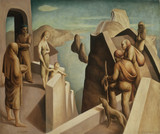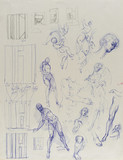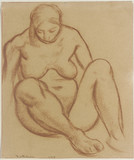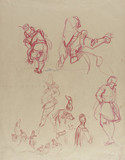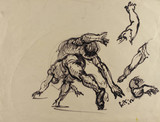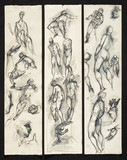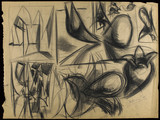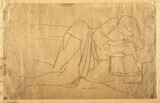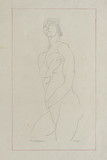Lorser Feitelson was the dean of Southern California modernism for half a century, the best-known proponent of surrealism on the West Coast, and one of the West’s earliest hard-edge painters. He devoted his entire career to developing a classical-abstract art, which he perceived as the most satisfying means of fusing the spirit of the Renaissance and modern art.
As a teenager in New York Feitelson was exposed to old master and modernist European and American painting simultaneously. He saw the Armory Show, read avant-garde art journals and Jerome Eddy’s Cubists and Post-Impressionists (1914), and by the age of eighteen had his own studio. In 1919 he visited Paris for the first time, and in the early 1920s he traveled to Italy. Influenced by Paul Cézanne (1839-1906), cubism, futurism, Henri Matisse (1869-1954), and André Derain (1880-1954), Feitelson experimented with kineticism and compositional structure. During the early 1920s he began to develop a neoclassical art, at first utilizing mythological and peasant themes.
After achieving success in New York, where he exhibited at the progressive Daniel Gallery, Feitelson settled in Los Angeles in 1927. He was immediately given solo exhibitions in Los Angeles and San Francisco. During the 1930s he opened the first gallery of contemporary art in Los Angeles, served as the supervisor of the murals, paintings, and sculpture section of the Southern California Works Progress Administration/Federal Art Project, and taught at a number of schools. In 1934 he and his wife, artist Helen Lundeberg (born 1908), developed an aesthetic that they called Subjective Classicism and which the critics dubbed postsurrealism. Responding to the Second World War, Feitelson began painting Magical Forms, a series of nonrepresentational images, in the hope that the forms would reflect a new world. In the 1950s his continued fascination with the purity of form and line led to his creating geometric, abstract, hard-edge paintings, and by 1959 Feitelson banded with three other West Coast hard-edge artists-Karl Benjamin (born 1925), Frederick Hammersley (born 1919), and John McLaughlin (18981976) -- as Abstract Classicists to exhibit their geometric, abstract paintings. Through the 1960s and 1970s Feitelson continued to develop his hard-edge paintings with a growing sensuousness of line and color.
BIBLIOGRAPHY
Archiv. Am. Art, Lorser Feitelson Papers and Helen Lundeberg Papers § Jules Langsner, "Permanence and Change in the Art of Lorser Feitelson," Art International 7 (September 25, 1963): 73-76 § Diane Degasis Moran, "The Painting of Lorser Feitelson," Ph.D. diss., University of Virginia, 1979, with bibliography § San Francisco Museum of Modern Art and Los Angeles, University of California, Frederick S. Wight Art Gallery, Lorser Feitelson and Helen Lundeberg: A Retrospective Exhibition, 1980, with text by Diane Degasis Moran, bibliography, list of exhibitions § Diane Degasis Moran, Feitelson: Three Analytical Essays (Los Angeles: Lorser Feitelson and Helen Lundeberg Feitelson Arts Foundation, 1981).


